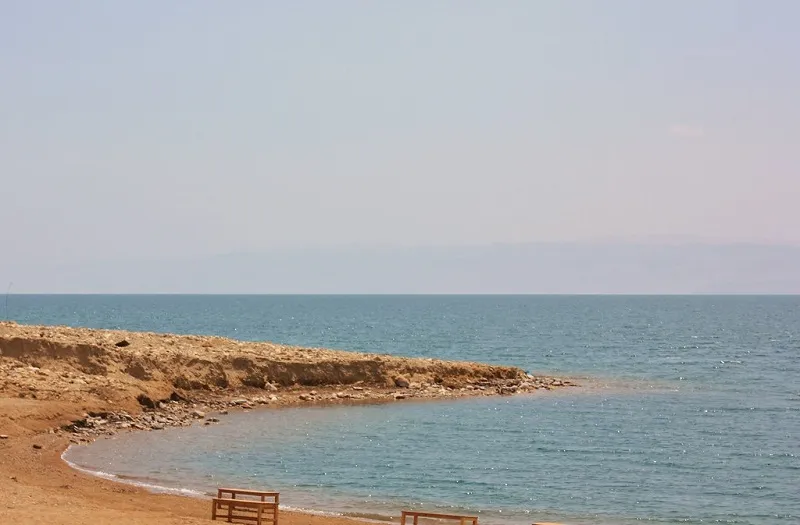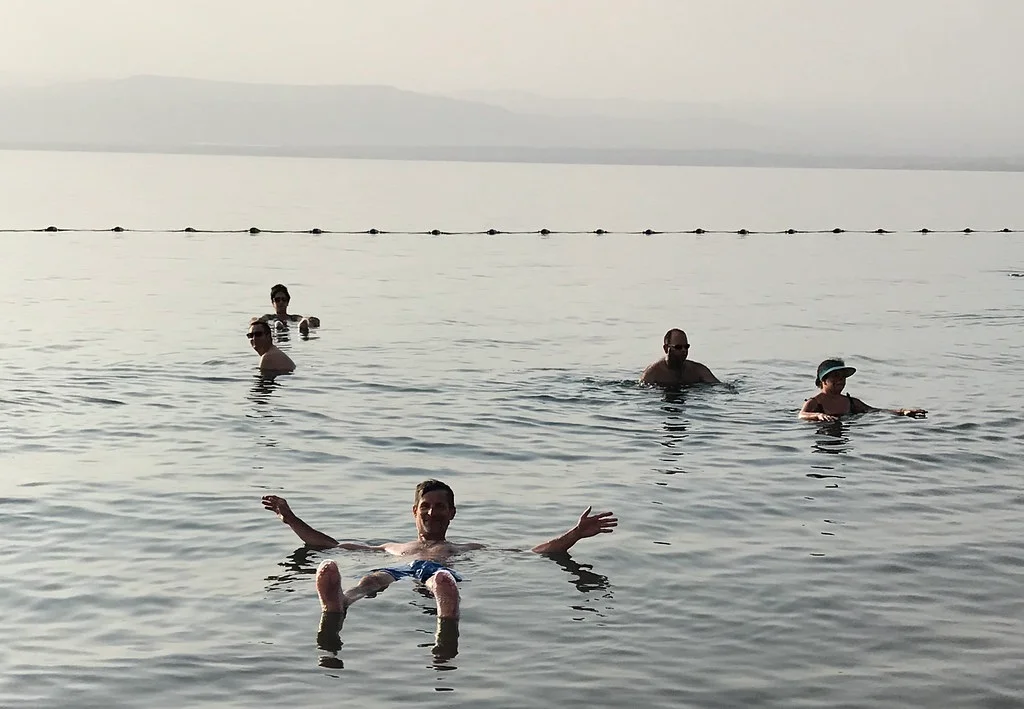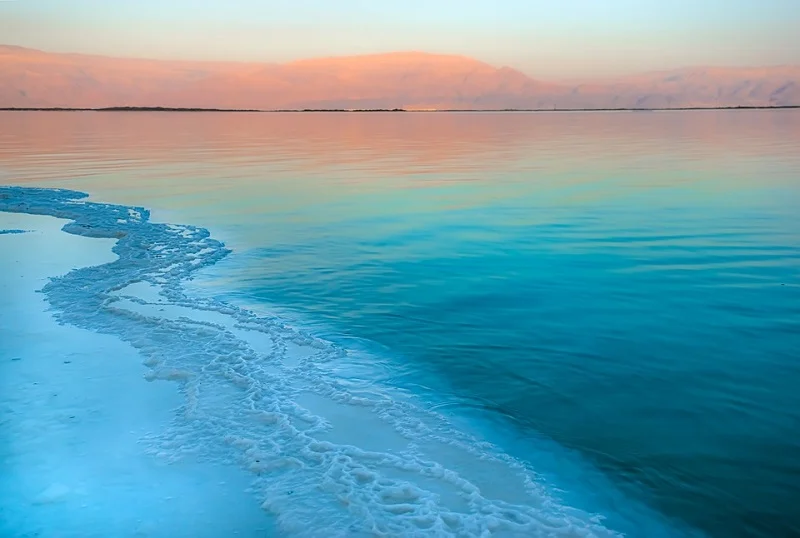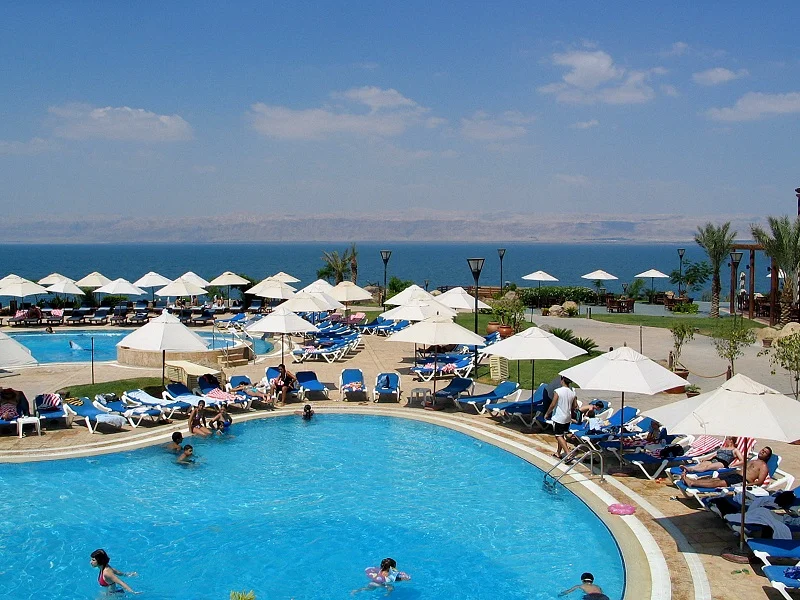
The Dead Sea, a breathtaking natural wonder that is 427 meters below sea level, is ideal for wellness and religious travel as well as family fun in the sun. Biblical experts may get their daily dosage of religious history while you can enjoy the beach life and religious history while you soak up the sun.
The Dead Sea’s warm, calming water is its main draw. It is 10 times saltier than seawater and contains high concentrations of chloride salts of magnesium, sodium, potassium, bromine, and other elements.
Since ancient times, tourists have been drawn to the extraordinarily warm, remarkably buoyant, and mineral-rich waters, including Herod the Great and the stunning Egyptian Queen Cleopatra. They’ve all luxuriated in the Dead Sea’s rich, black, stimulating mud, floating easily on their backs and soaking up the water’s beneficial minerals and the sun’s softly dispersed rays from Jordan.
History of the Dead Sea in Jordan
The Dead Sea’s history dates back to the Hellenistic era, and it has been mentioned in numerous biblical passages, including Noah’s Ark. For economic and military purposes, the Dead Sea was crucial during the Roman and ancient Greek eras of control. Despite its importance for trade, the sea remained blocked from 1453 until the Treaty of Paris reopened it in 1856.
It is still a major economic hub today and a fantastic resource for nearby fishermen. A vacation to the Dead Sea is also highly well-liked by both locals and tourists because it offers swimming, diving, and snorkeling opportunities.
Location
The Dead Sea is situated in a commanding location, bordering both Jordan and Israel. It extends throughout the Jordan Rift Valley for 67 kilometers and can be up to 18 kilometers wide.
The Dead Sea is bordered by numerous stunning beaches in both Israel and Jordan. The beaches of Jordan are near the hotel district and are situated towards the northeast.
Couples will love Jordan’s beaches because they are much more peaceful than those in Israel’s bigger resorts. It is the perfect location for a vacation to the Dead Sea because there are so many tourist-friendly restaurants, bars, cafes, and hotels there.
Facts regarding the Dead Sea Of Jordan

It is a lake! A body of water must be connected to an ocean to qualify as a “sea.” It doesn’t at the Dead Sea. The Jordan River serves as its source, making it an island. Due to its geographic isolation, the Dead Sea’s water evaporates quickly, leaving behind masses of salt.
Because of the Dead Sea’s high salt content, people can float on top of it because it is so dense. The Dead Sea is nearly ten times saltier than regular seawater, with an average salinity of 33.7%.
Due to the inability of plants and animals to live there, the Dead Sea got its name. It’s just too intense with that much salt! Microbes can still survive in salt, even while larger organisms cannot. At the bottom of this purportedly lifeless lake, microscopic populations of bacteria have reportedly been discovered by scientists.
Sadly, the Dead Sea is getting smaller, and it’s getting smaller quickly. Even while experts predict that it won’t dry up, its surface level is now decreasing by more than a meter (3 feet) every year. And it’s mostly due to unsustainable human behavior.
The Dead Sea hasn’t been able to renew itself because some of the nearby natural water sources have been diverted since the 1960s. To preserve our ability to enjoy the water, scientists are currently making great efforts to slow the sea’s shrinkage.
Climate Of The Dead Sea
Any vacation to the Dead Sea must begin with careful planning. This is because the climate of the Dead Sea is special and distinct from the surrounding locations in Israel, the country that is home to the salty sea. The Dead Sea offers a little bit of everything, including stunning waters, risk-free sunbathing, the well-known floating experience, opulent hotels, massage and spa treatments, mud wraps, fine dining, and a tonne of hiking trails nearby. As a result of this diversity, everyone can find the ideal time of year to visit the Dead Sea.
The sea is nice and welcoming all year round because the water temperature fluctuates from 22 to 35 degrees Celsius for those who want to take a plunge. The fact that you will be exposed to less UV radiation than you would at other nearby beaches is another significant benefit of lounging on the Dead Sea coastline. This is because the water level is quite low, which causes the UV rays to be filtered and weakened before they reach your skin.
The region’s very infrequent precipitation, winds, and humidity levels all have a significant impact on the Dead Sea’s average temperatures. Generally speaking, the majority of the year’s Dead Sea weather makes for a relaxing and enjoyable stay in the region.
Best Time To Visit the Dead Sea Of Jordan

The Dead Sea in Winter (December – February):
The greatest season, according to some, to visit the Dead Sea is winter. After all, much of the world is on vacation over the new year, therefore a lot of people are looking for a good vacation spot. While the northern hemisphere is covered with snow and many locations experience below-freezing temperatures at this time of year, the average temperature in the Dead Sea is remarkably pleasant.
During the winter, there are only two days of rain each month on average. Swimming is a particularly enjoyable activity when combined with various spa treatments for the body and spirit because the water temperature is greater than the air temperature.
Make sure to keep this in mind before booking a flight because this is the Dead Sea’s busiest time, and with good reason – mild temps (but not too hot), with little possibility of rain. The Masada hike is manageable (thanks to the favorable weather), the tourist attractions, such as Ein Gedi Nature Reserve, are lush and in flower, and the eateries are lively and full of life.
The Dead Sea in Summer (June – August):
In the Dead Sea region, these are the warmest months. June has slightly cooler average temperatures than the hottest months of July and August, which is why it is considered to be rather “pleasant.” The sea is cool and pleasant in the summer since the water’s temperature is lower than the surrounding air’s. Compared to other summer vacation spots in Israel and across the world, there is less humidity, and the sun’s radiation is less hazardous.
At the Dead Sea, you can safely tan if you use the correct sunscreen. By the way, because of the intense heat, especially in August, hotel rates dramatically decline, and people who plan to take advantage of luxurious massages and beachside entertainment can often discover fantastic offers. It is preferable to travel to the Dead Sea region during other, cooler seasons of the year if you suffer from the heat and, of course, if you wish to explore the nearby trails.
The Dead Sea in Fall (September-November):
The best time of year to visit the Dead Sea is right now. The Jewish holy holidays—Rosh Hashanah, Yom Kippur, and Sukkot—are national holidays in Israel for a portion of the year, thus hotels are booked solid, and costs increase. The region is teeming with thrilling events, including Masada and the outstanding Tamar music festival at the Dead Sea.
The temperatures decline from the middle of October until the end of November, and prices follow suit. Additionally, during these months, you can take magnificent desert strolls and visit the adjacent Ein Gedi Nature Reserve to observe migratory species.
Salinity
The Dead Sea’s waters are incredibly salty, and typically, the salt content rises as you get closer to the lake’s bottom. For extended periods, the event can separate the lake’s water into two distinct masses. Until the late 1970s, such a condition persisted for around three centuries. The temperature ranged from 66 to 98 °F (19 to 37 °C), the salinity was just under 300 parts per thousand, and the water was particularly rich in sulfates and bicarbonates down to a depth of around 130 feet (40 meters).
The water was uniformly 72 °F (22 °C) in temperature and had a higher salinity (approximately 332 parts per thousand); it also contained hydrogen sulfide and strong concentrations of magnesium, potassium, chlorine, and bromine. The zone of transition was found at depths between 130 and 330 feet (40 and 100 meters). Sodium chloride precipitated to the bottom after becoming saturated in the deep water. Thus, the deep water turned into fossils.
The Jordan River’s drastic decline in inflow, which started in the 1960s steadily, increased the salinity of the Dead Sea’s upper-layer waters. By the late 1970s, that water mass had increased in salinity (and density) relative to the lower levels, but it did not sink since it remained warmer than those layers. However, by the winter of 1978–1979, the upper-level layer had cooled and saturated to the point where it could descend, resulting in an event known as an overturn (a mixing of the water layers). Since then, there have been other episodes of overturning, although the tendency has been toward restoring the once-stratified water layers.
The high density of the salt water makes swimmers afloat. The Jordan River’s freshwater remains on the surface, and in the spring, it may be seen spreading southward from where the river empties into the Dead Sea. All life is prohibited by the lake’s severe salinity, except for microorganisms. When there is flooding, fish brought in by the Jordan or by smaller streams die swiftly. Except for the flora along the rivers, the plant life around the shoreline is sporadic and primarily composed of halophytes.
Dead Sea resorts in Jordan

Several resorts that cater to guests looking to unwind and enjoy the salty water are located along the Jordanian side of the Dead Sea. Every resort features its own, well-kept beach that is accessible from the Dead Sea.
A hotel will provide beach chairs and room for lounging for your Dead Sea plunge, as well as freshwater showers and Dead Sea mud for sale. In addition to these benefits, the resorts offer a wide range of other facilities, including restaurants, spa services, and pools with fresh water. The Merriott Dead Sea Resort & Spa is one of the greatest hotels in the Dead Sea.
On the banks of the mineral-rich Dead Sea, this Marriott Dead Sea Resort & Spa is surrounded by untamed mountains. It has whirlpools, saunas, and pools with both saltwater and freshwater. All of the air-conditioned rooms have tranquil color schemes and balconies, some of which have Dead Sea views.
Luxurious down comforters and feather pillows are used to make the beds. There is a minibar, safe, and hairdryer accessible. The rooms in our inn have all recently been updated. The resort is now smoke-free as well. Smoking is not permitted inside any guest rooms or public areas.
The expansive spa at the Marriott Dead Sea Resort provides a relaxing haven where guests may indulge in revitalizing beauty and wellness treatments. A lap pool and massage baths are also available.
The Dead Sea Resort & Spa offers a steakhouse, and two restaurants serving Italian and international cuisine. The Champions Sports Bar and Oasis Lounge, which provide views of the Dead Sea and water pipes, are among the bars available.
The Queen Alia Airport is within a short drive from this resort. Only 35 kilometers separate you from Madaba, a city renowned for its historic mosaics. Free parking is available at the motel. Couples in particular enjoy the area; they gave it a 9.2 rating for a trip with a partner.
Conclusion
Even though it isn’t a sea, the Dead Sea Of Jordan is a must-see on any vacation to Israel. In reality, it’s a lake—and a very, very salty one at that. An interesting location with distinctive historical and geographical elements is the Dead Sea. Although it is referred to as the Dead Sea, this body of water is a lake. Being a landlocked salt lake in the Middle East, the Dead Sea is sandwiched between Israel and Jordan.
